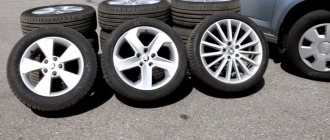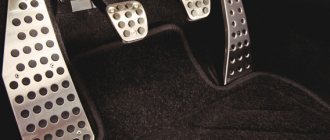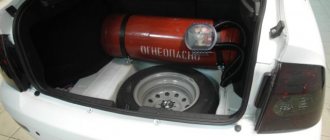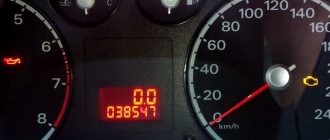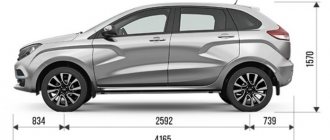With a working engine, an impeccable gearbox, and a new chassis, the car will not go anywhere without a clutch. On the Lada Vesta this is one of the most important components. The task of a mechanical clutch is to connect the internal combustion engine and manual transmission, transmitting torque from the engine to the chassis, and also to separate them when changing gears (if you leave the gearbox input shaft rotating through the internal combustion engine, the gears will inevitably be damaged).
The Lada Vesta clutch on a manual transmission (mechanical) consists of one disc, engagement is made mechanically (dry, permanently closed type), the drive is hydraulic. The latter means that the unit is driven by fluid pressure and is adjusted manually (by foot) by the driver. In addition, the fluid system acts as a pedal booster. After all, simply pressing with your foot is not enough to set in motion the structure, which engages with the shaft while rotating several thousand revolutions. Therefore, there is no need for hydraulics on an AMT. Read the article to the end and you will learn the intricacies of this knot! Find out the problems that often happen and the clutch drive fails: the release bearing or the basket as a whole is broken. It's time to change, or adjust enough, precise adjustment is important for good operation of the unit. Replacement at the dealer at 9 TO.
Clutch replacement on Lada Vesta cars under warranty
You can replace the clutch on a Lada Vesta under warranty. A similar procedure can be carried out when the car breaks down during the first 20,000 kilometers. If it is proven that neither the driver nor third-party manipulations are involved in the malfunction of the unit, the service center will carry out repairs free of charge. After the replacement, the brakes will also be bled. This is a mandatory process for a hydraulic drive, since after the intervention air cavities (plugs) are formed in the system. For a robotic gearbox, another manipulation is carried out - adaptation.
Under warranty: replacement of the clutch mechanism is also included in the list of TO9 works for the Lada Vesta. Even if the unit is working, it will have to be replaced. There is no need to worry about this; the life of the part has come to an end anyway, and it will not last long.
Reviews
| № | Positive |
| 1. | Victor (www.zr.ru): drove 60,000 km, recently replaced the fluid. There are no comments on the functionality of the units. |
| 2. | Andrey (autobann.su): the gearbox was tapping when it was cold, after visiting the service station it turned out that the oil level was insufficient. |
| 3. | Georgy (lada-vesta.net): Vesta’s clutch is good and lasts a long time, of course, with proper maintenance. |
| 4. | Stepan (otzovik.com): I bought a used car, got it in good condition, no comments. |
| 5. | Vladimir (www.zr.ru): positive review, details are widely available, average price. |
| 6. | Alexander (autobann.su): I have driven 25,000 km in two years, the car is in like new condition. |
| 7. | Mikhalych (vesta.ru): for the third season the car has been parked in an open parking lot, the engine starts the first time, the clutch does not stick. |
| 8. | Vitaly (lada-vesta.net): at the next scheduled maintenance there were again no comments from the foreman. |
| 9. | Timofey (otzovik.com): mileage is 49,000 km, the car is in normal condition, the pedal grabs the top. |
| 10. | Stanislav (www.zr.ru): at Grant the quality of parts and mechanisms was worse, at Vesta the engineers improved it and improved it a little. |
| 11. | Gennady (autobann.su): I’ve heard negative reviews about Vesta, but I don’t agree, since the equipment needs maintenance. |
| 12. | Alexey (vesta.ru): systematically carry out maintenance, buy original parts and you will be happy. |
| Negative | |
| 13. | Konstantin (www.zr.ru): when switching from second to third gear, a crunching sound has been heard for a long time. It's expensive to repair; the warranty was rejected by the dealer. |
| 14. | Vitaly (otzovik.com): Vesta’s robot is weak, it’s better to choose a configuration with mechanics. |
| 15. | Grigory (autobann.su): once every two years I regularly go to a service station to repair the transmission; the sensor on the dashboard indicates a breakdown. |
| 16. | Kirill (lada-vesta.net): the model was updated, but the defects that were inherited from previous generations were not eliminated. My clutch master cylinder failed after 50,000 km. |
Related link:
Everything you need to know about Lada Vesta tires. Choosing the right tires
Clutch adjustment on Lada Vesta cars
Since the knot is constantly engaged/disengaged, it needs fine adjustment. Adjustments are made on site during installation. The driven disk is centered, the basket, and the release bearing are also centered - they must fit exactly into the splines of the flywheel and the input shaft of the gearbox.
In the future, you can adjust the position of the clutch cable so that the pedal is softer/harder, so that it responds better to the command (during operation, the cable may stretch).
On a Lada with a robotic gearbox, the clutch is regulated by special programs. Adaptation can only be completed at an official dealer. However, the service life of the AMT clutch is significantly longer than that of a manual transmission.
Frequently asked questions about adapting a robotic box
- Turn on the ignition and connect to the car using the ELM327 adapter and DDT4ALL software.
- Select in the upper left window XGA-XRAY - AT - BVR_On_CAN_x52_J53_v2.4
- In the middle window [AT] BVR_On_CAN_x52_J53_v2.4
- In the lower left After sales - Learning Procedures
- Press the button with the image of a “face”
- Carry out the learning procedure by clicking on the appropriate button.
- Turn on the ignition, but do not start the engine. Carry out training of the clutch actuator end positions. Execution time is about 5-6 seconds. (you will hear the actuator moving).
- After the operation, press the “STOP” button and turn off/on the ignition.
- We wait 5-10 seconds and start the gearbox learning procedure. We do not turn off the ignition. Execution time is about 1 minute.
- After the operation, press the “STOP” button and turn off/on the ignition.
- Start the engine and wait 15-20 seconds, then start learning the clutch touch point. Execution time 5-10 seconds.
- After the operation, press the “STOP” button and turn off the ignition. Wait for the main relay to turn off (about 4 minutes)
- We start the engine and check.
- Turn on the ignition and connect to the car using the ELM327 adapter and DDT4ALL software.
- Select in the upper left window XGA-XRAY - AT - BVR_On_CAN_x52_J53_v2.4
- In the middle window [AT] BVR_On_CAN_x52_J53_v2.4
- In the lower left After sales - Diagnostic.
- We make sure that the two selected windows have non-zero values.
- Click on the “heart” icon in the top menu, remember or write down the errors, then erase the errors.
How long does it last? The adaptation process takes about 5 minutes. During adaptation, the car adjusts the clutch, then turns off and saves the settings
How to adapt the clutch? Clutch adaptation is carried out using special equipment via the diagnostic connector. It is best to have the clutch adaptation done by a dealer rather than by a third-party service; besides, the dealer will be cheaper.
How much does a clutch adaptation cost? Under warranty, adaptation is free. In other cases, it all depends on the region. In third-party services - from 2 tr.
Analogs
The manufacturers themselves recommend 826818 VALEO 2180 for Vesta. Owners note that when using the model, the pedal becomes noticeably softer and the car starts easily. The note applies to the original set; fakes are often found. The spare part costs four thousand eight hundred rubles.
The original part of the Lada Vesta is not suitable for the 21129 engine in terms of power; it is designed for lower speeds, for example, such as 2112. For 106 horsepower and above, TS-00001321 would not be a bad match. Price – five thousand six hundred rubles.
Required Tools
For the procedure you will need to prepare a certain kit.
- Set of wrenches from No. 10 to No. 24. You will also need socket heads.
- Screwdrivers – Phillips and flathead. Tools may be required in different sizes.
- Set of hex keys. Some bolts will have to be removed. Therefore, hexagons of normal quality will be required. When using a “disposable” tool, you can lick off the screw heads, which will result in their replacement.
- Rags – you will need a lot of rags, preferably clean ones.
- A torque wrench will be needed when reassembling the machine. It is strictly not recommended to tighten the bolts without it, by eye.
- A soft metal brush is needed to clean surfaces from dirt crusts.
- Clean containers for draining process fluids. If the car is still far from scheduled maintenance, it is not cost-effective to dump oils and other mixtures into scrap.
- A set of special plugs. If there are none, you can select a similar set of rubber plugs.
- Pliers with long and narrow pliers. You can use ordinary ones - it will be more convenient to carry out repairs with special ones.
Signs of clutch failure
The occurrence of malfunctions in the Vesta clutch mechanism is most often associated with improper operation (inexperience of the driver, aggressive driving style), an initial defect in the part, or breakdown of other components interacting with it. Of course, you will immediately notice problems with the clutch - the car will begin to behave differently:
- Gears are difficult to shift/do not work at all;
- Pedal too soft/hard;
- The car jerks;
- The device is activated in the upper position of the pedal.
There can be many reasons for this behavior of Vesta, and not all of them are related to the intermediate part between the internal combustion engine and the gearbox. Often the problem comes from the fluid system. There may be a malfunction of the brake master cylinder, clutch slave cylinder, damaged hoses, a simply low DOT4 level or an air lock. Such problems (especially problems with the cylinder of the unit) have exactly the same effect as the failure of the entire unit. The clutch consists of a housing cast together with the drive/pressure plate (basket) and the driven disc. The release bearing of the Lada Vesta acts on the petals of the basket, which, in turn, with the help of damper springs, press the inner disk away from the flywheel - the clutch opens. The bearing moves either under the influence of the hydraulic pedal drive (manually) - manual gearbox, or from the actuator (automatically) - manual gearbox. These parts can fail: more often - the release mechanism, less often - the basket body. Let's take a closer look at the most common “breakdowns”.
Specifications
| Lada Xray Cross | Lada Vesta SW Cross | Chevrolet Niva | |
| Price | 914,000 rub. | 884,000 rub. | 776,000 rub. |
| Issued from | 2018 | 2017 | 2002 |
| Motor and gearbox | |||
| Engine | petrol / 1774 cm³ | petrol / 1774 cm³ | petrol / 1690 cm³ |
| Power | 122 hp | 122 hp | 80 hp |
| Transmission | mechanical / 5 steps | mechanical / 5 steps | mechanical / 5 steps |
| Drive unit | front | front | full |
| Acceleration to hundreds | 10.3 seconds | 11.2 seconds | 19 seconds |
| Maximum speed | 179 km/h | 180 km/h | 140 km/h |
| Fuel consumption | 9.3 / 5.8 / 7.1 l/100km | 10.7 / 6.4 / 7.9 l/100km | 13.2 / 8.4 / 10.2 l/100km |
| Body | |||
| Ground clearance | 215 mm | 203 mm | 220 mm |
| Dimensions (length × width × height) | 4165 / 1764 / 1645 mm | 4424 / 1785 / 1532 mm | 4056 / 1800 / 1690 mm |
| Trunk volume | 361 l | 480 l | 320 l |
| Fuel tank volume | 50 l | 55 l | 58 l |
| Vehicle weight | 1250 kg | 1280 kg | 1410 kg |
| Safety | |||
| Anti-lock braking system (ABS) | There is | There is | There is |
| Stabilization system (ESP) | There is | There is | unavailable |
| Number of airbags | 2 | 4 | 2 |
| Driver airbag | There is | There is | There is |
| Front passenger airbag | There is | There is | There is |
| Front side airbags | unavailable | There is | unavailable |
The clutch does not disengage (drives)
Often, the Lada mechanism does not fully release due to the hydraulic clutch release. This could be due to poor drive adjustment, leaking fluid system, or cable wedge. Such breakdowns are easily eliminated. It is much more difficult when one of the elements of the main device breaks down.
If the mechanism does not completely disengage, it means that something is holding it: a deformed driven circle, the formation of dirt, rust in the spline joint, flywheel wear, as well as a change in the shape of the release fork, weakening of the pressure plate. In all cases, the disk will need to be replaced.
7) Prices for new AvtoVAZ products
Whatever the technical characteristics of the Lada Vesta and Lada XRay, the price often becomes a key indicator of the car’s availability.
Depending on the engine-gearbox combination, configuration and set of additional options, the cost of the Vesta sedan starts at 569,900 rubles and rises to 824,400 rubles. The price of the Hray hatchback is from 614,900 to 845,900 rubles. That is, Vesta has reasonable prices. Considering its modification, the SV Cross station wagon with its price in the range of 770,900-866,900 rubles, then against its background the price of the hatchback becomes attractive. Cross is already a different car for 2022, although it was correct to compare Ray with it!
Basic equipment
The Vesta database includes rear door locking, 3 rear head restraints, 2 airbags and automatic locking on the go, ABS+BAS, TCD, NSA, EBD, ERA-GLONASS, ESC and engine protection. X Ray has the same thing, with a small caveat - there are 2 rear headrests. In external parameters these are: 15-inch stampings with caps, mirrors with built-in turn signals, DRLs, side mirrors and black door handles for Vesta. The same for Xray, but without DRLs and decorative caps, and the color of the mirrors and handles matches the color of the body. The interior features a fabric interior, an on-board computer, a 12V socket, a split sofa back (60/40) - Vesta, plus a mirror in the passenger visor - X-Ray. In terms of comfort, the hatchback is much better equipped. Steering wheel with height adjustment, electric power steering, front windows with electric lifts, central locking, light tinting, multifunction steering wheel, audio system and 4 speakers allow you to significantly beat Vesta with its set: steering wheel with height and reach adjustment, electric power steering, front windows with electric lift, central locking , electrically adjustable and heated mirrors, light tinting, electrically heated front seats, music preparation. Taking into account the options, the basic equipment of the X-Ray is more thoughtful and comfortable than that of Vesta.
Maximum configuration
In Vesta, this is the “Luxury” package, including 16” alloy wheels, mirrors and handles in the body color, height adjustment of the driver’s seat, full power accessories and a bunch of bells and whistles, such as parking sensors with a rear view camera, a multimedia system with 6 speakers, air conditioning and a cooled glove compartment, an armrest, an eyeglass case, a mirror in the passenger visor, climate control with rain and light sensors, a heated windshield and, of course, door lighting when exiting. X-Ray's Top-Prestige also has these parameters, with the addition of fog lights, a drawer under the front passenger seat, a double floor in the trunk, electric mirrors and a heated glove box, and enhanced tinting of the rear windows. Like the basic, maximum configuration of the hatchback is equipped with a wider range of options.
Jerks when starting off
If you notice that the movement is accompanied by twitching, this is a serious reason to seek help from specialists. The Lada Vesta can shake for various reasons (for example, ignition failures), but if it is the clutch mechanism that gives the effect, we are talking about scrap parts. Obsolescence will never be accompanied by jerks, but destruction, the breaking off of pieces of metal, manifests itself this way. The presence of freely moving debris can cause great damage to other Vesta nodes. It is recommended to carry out repairs immediately.
LADA XRAY_Zahod
This is the first photo of Xray without camouflage.
The photo was taken in the Pilot Production, where several dozen machines intended for testing and testing technological processes were assembled. We were asked to hold off on publishing other photos of finished cars. This is the first photo of Xray without camouflage. The photo was taken in the Pilot Production, where several dozen machines intended for testing and testing technological processes were assembled. We were asked to hold off on publishing other photos of finished cars. This is the first photo of Xray without camouflage. The photo was taken in the Pilot Production, where several dozen machines intended for testing and testing technological processes were assembled. We were asked to hold off on publishing other photos of finished cars.
I don’t know about anyone, but Boo Andersson hypnotizes me. Because you can look at three things endlessly - at fire, at water and at how Boo talks about his factory.
— This is our motor production. The assembly of Renault H4Mk engines (114 hp) began on June 24 - two thousand units have already been sent to Avtoframos, and by the end of the year we will make another nine thousand. We are also mastering the new 123-horsepower 1.8 VAZ-21179 engine, which will go primarily to the XRAY. Look how clean it is all around - Europe! We have invested millions of rubles in renovating toilets, changing rooms and workers' rest areas.
What does the president of AVTOVAZ care about toilets? Andersson cares about everything. And if one day it turns out that somewhere under his skin he has a powerful chip sewn in, I won’t be surprised: not one of the top managers, neither from ours nor from “theirs,” dumped so much information on me in a unit of time.
Step-by-step instruction
Replacing the clutch on a Lada car will require a lot of time, effort, money and experience. Many car enthusiasts practice DIY repairs due to the high cost of professional services.
Prevention is complicated by the fact that the VAZ design has a pre-installed subframe that limits access to the units. In order to provide methodological assistance to owners of technical equipment, using the Lada Vesta car as an example, we will consider the process of independently replacing the clutch.
Messages 13
1 Topic from Andre-y 2016-09-04 12:43:27
- Andrey
- New member
- Inactive
- Messages: 3
- Thank you: 0
Topic: Vesta clutch adjustment
Hello to everyone who will come.
I’ve driven the West for 1000 km and I can’t get used to the clutch, just when I’m moving off, well, the clutch grabs at the very end, so you still have to release it very slowly and for a long time in order to start normally and not stall the engine, and keep the speed at least 1500-1700. Is it so hard for everyone to start moving and is it possible to adjust the clutch? Before this I had a Priora, even if I let go of the clutch more frequently, I still pulled away confidently, but in the West the engine stalled.
2 Reply from Fan 2016-09-04 19:07:49
- Fan
- Moderator
- Inactive
- From: Smolensk region
- Messages: 1,017
- Thank you: 204
Re: Vesta clutch adjustment
I got into the Vesta in the cabin and immediately took off and drove off. You probably don’t have enough experience; you need to feel when the engine is choke. And don’t forget that Vesta, unlike Priora, has a hydraulic clutch, not a cable.
3 Reply from Andre-y 2016-09-04 19:42:03
- Andrey
- New member
- Inactive
- Messages: 3
- Thank you: 0
Re: Vesta clutch adjustment
I got into the Vesta in the cabin and immediately took off and drove off. You probably don’t have enough experience; you need to feel when the engine is choke. And don’t forget that Vesta, unlike Priora, has a hydraulic clutch, not a cable.
I went for a test drive, and somehow I didn’t feel any grip, so I sat down and drove off. And when I bought the Westa, I started driving, and that’s where it all began. Maybe during the test drive the clutch was adjusted a little better and grabbed in the middle, but on mine it was at the very end.
4 Reply from rvs 2016-09-04 21:55:00 (2016-09-04 21:55:29 edited by rvs)
- rvs
- Participant
- Inactive
- Messages: 97
- Thank you: 31
Re: Vesta clutch adjustment
Maybe during the test drive the clutch was adjusted a little better and grabbed in the middle
How can you adjust the hydraulic clutch drive? Someone invented the know-how.
5 Reply from Andre-y 2016-09-05 18:14:41
- Andrey
- New member
- Inactive
- Messages: 3
- Thank you: 0
Re: Vesta clutch adjustment
Essentially no one answers my question. Does anyone even ride West?
6 Reply from rvs 2016-09-05 20:41:53
- rvs
- Participant
- Inactive
- Messages: 97
- Thank you: 31
Re: Vesta clutch adjustment
Nobody actually answers my question.
What answer are you expecting? The clutch is adjustable only on a cable drive. Vesta has a hydraulic drive. What can be adjusted there?
7 Reply from Klyuv 2016-09-06 09:15:23
- Beak
- Participant
- Inactive
- From: Moscow region
- Messages: 301
- Thank you: 46
Re: Vesta clutch adjustment
The clutch is adjustable only on a cable drive. Vesta has a hydraulic drive. What can be adjusted there?
Wait, what seems so strange and impossible to you? I don’t know, maybe specifically on Vesta they made the unit unregulated, but in general the free play is adjusted in the same way on hydraulically driven systems. There is no fundamental difference.
8 Reply from rvs 2016-09-06 12:44:33
- rvs
- Participant
- Inactive
- Messages: 97
- Thank you: 31
Re: Vesta clutch adjustment
but in general, free play is adjusted in the same way on hydraulically driven systems. There is no fundamental difference.
Front-wheel drive VAZs have had a backlash-free clutch for 30 years (or whatever has passed since the release of the first eight). If its drive is cable, then adjustment is made with nuts on the cable; if the drive is hydraulic, then there is no adjustment. In general, there is no need to confuse the hydraulic clutch drive on the classics, where the clutch (free play) was adjusted between the nut on the pusher and the fork.
9 Reply from Klyuv 2016-09-06 16:40:01
- Beak
- Participant
- Inactive
- From: Moscow region
- Messages: 301
- Thank you: 46
Re: Vesta clutch adjustment
It’s not just the classics that have used and still use a hydraulic drive with adjustable pedal travel. If you know for sure that this is not provided for on Vesta, then that means it is. But this is not because “it can be adjusted on a hydraulic drive.”
10 Reply from Lumi 2016-09-21 20:13:55
- Lumi
- Moderator
- Inactive
- From: St. Petersburg
- Messages: 580
- Thank you: 102
Re: Vesta clutch adjustment
you need to feel when the engine is choking.
Injection at 1.5 thousand?
I feel the problem may be in the check valve, which, when the brake is suddenly released, does not allow the brake fluid to quickly flow back.
11 Reply from antifashist 2016-09-22 12:49:33
- anti-fascist
- Moderator
- Inactive
- From: Salavat, Bashkortostan
- Messages: 708
- Thank you: 73
Re: Vesta clutch adjustment
I’ve driven the West for 1000 km and I can’t get used to the clutch, just when I’m moving off, well, the clutch grabs at the very end, so you still have to release it very slowly and for a long time in order to start normally and not stall the engine, and keep the speed at least 1500-1700. Is it so hard for everyone to start moving and is it possible to adjust the clutch? Before this I had a Priora, even if I let go of the clutch more frequently, I still pulled away confidently, but in the West the engine stalled.
What does the dealer say? Must check.
12 Reply from Sergey Kurdyukov 2018-08-06 14:05:06
- Sergey Kurdyukov
- New member
- Inactive
- Messages: 1
- Thank you: 0
Re: Vesta clutch adjustment
I drove the West for 1000 km and can’t get used to the clutch
I've already driven 16 thousand in a year and a half and I can't get used to the clutch. Before that I had Kalina, and although its clutch is stiffer, I got used to its clutch in a couple of weeks. Moreover, in Kalina I could shift in any gear without a transmission jerk. On Vesta it works normally only at 3rd and higher.
| Turn off the engine and press the clutch pedal two or three times. | There should be no jamming, creaking, knocking or any other extraneous sounds in the drive mechanism. |
| Start the engine. | If at the same time a howling sound is heard from the manual transmission, which becomes more distinct when the pedal is depressed, it means that the release bearing is badly worn and needs to be replaced. |
| With the engine running, depress the clutch pedal and engage any speed. | At the same time, there should be no creaks, knocks, or crunches. Otherwise, extraneous sounds indicate incomplete disengagement of the clutch. This usually indicates airing of the system. If there is no air, it means there is a malfunction of the master or working cylinder, or a broken diaphragm spring. |
| With the engine running, turn on the speed and smoothly release the clutch pedal. | When the car starts to move, there should be no jerking or extraneous noise. Otherwise, the cause of failure may be damage to the discs, damper, or oil getting on the discs. |
| While driving, you need to press the accelerator pedal sharply. | If the revolutions have increased, but the car has barely accelerated, it means the clutch is slipping. It is easy to understand about slipping by the characteristic burning smell from the friction linings of the disc in the cabin. The problem is solved by replacing the disks. |

